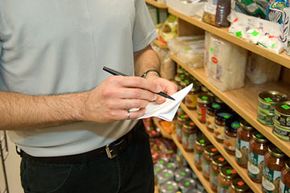Home Improvement

Having a shopping list can help you avoid impulse buying.
©2010 Jupiterimages Corporation
Regardless of whether you enjoy, detest, or simply tolerate grocery shopping, it is an essential part of everyone’s routine. Shopping can be time-consuming and frustrating, with many people returning home only to realize that they forgot to purchase the item they had intended to. This is why creating a shopping list can make your grocery shopping, or any household shopping, easier to manage and less expensive.
Shopping with a list helps you keep track of what you need and reduces the likelihood of impulse buying. This not only saves money but also ensures that your kitchen is stocked with the necessary foods to get you through the week [source: Zen Habits]. Nothing is more frustrating than planning a special meal and then realizing that you forgot a crucial ingredient, but with a shopping list, you can avoid this situation.
If you organize your shopping list well, you can also cut down on the time spent in the grocery store, allowing you to spend more time doing the things you love [source: Alan’s Kitchen]. There is no single perfect way to organize a grocery list. You’ll need to consider your shopping style and how detailed you want to be, and you may also need to have several lists if you do your shopping at two or more stores.
If you typically do not use a shopping list or are looking to revamp the way you currently organize your list, there are many resources available to help you, from general shopping lists to websites and software. To get started on your new shopping routine, read the next page for tips on how to organize your shopping list.
Techniques for Arranging Your Shopping Lists
When creating your shopping list, you may jot down whatever items come to mind. While this is a good way to write down many of the important items you need, it does not guarantee that you will remember everything, and it certainly is not the best way to organize your list. Simplifying your list before you shop will make your trip quicker and easier.
You may want to keep a list accessible for the whole week so that you can jot down things as you run out of them. This will help you when it is time to make your list because you will not forget an essential item [source: The Frugal Shopper]. Creating a meal plan for the week will also assist you in drafting your list. Write down only the items you need to prepare those meals, and you will avoid purchasing any extraneous items.
Once you have a list with all the items you need, take a few minutes to organize it before you go to the store. This will save you time in the store. One of the most common ways to organize your list is by food group. At most stores, fresh produce will be in one area, dairy products in another, and so on. If you have everything you need in a specific food group listed together, you will be less likely to miss something.
If you’re trying to stick to a budget but still want to get everything on your list, consider organizing your list by prioritizing necessary items first and leaving non-essentials for last. This way, you can work your way down the list within your budget. For even more organization, try grouping items by sections or aisles in your regular grocery store. To do this, create a master list of what can be found in each aisle and use it to list your groceries in the order you’ll come across them in the store. If you need help getting started, there are many websites with general shopping lists available. For a more high-tech solution, consider using shopping list software. Many nutrition websites offer grocery list generators that allow you to save lists for future reference, while downloadable software can even store recipes and plan meals. To avoid impulse buying, make sure you eat a full meal before heading to the store.
Additional Information
Related Articles from HowStuffWorks
- Ways to Optimize Storage Space
- Tips for Garage Organization
- Methods for Organizing Your Closet
- How Crafts Made from Recycled Copper Work
- How Crafts Made from Recycled CDs Work
- How Crafts Made from Recycled Newspapers Work
Sources
- Alan’s Kitchen. “Master Organized Grocery List: Step 8 of Grocery Shopping Tips.” 2009. (Accessed 1/11/10) http://www.alanskitchen.com/Smart_Shopper/Smart_011.htm
- The Frugal Shopper. “Grocery Shopping Tips.” 2008. (Accessed 1/11/10)http://www.thefrugalshopper.com/tips/grshopping.shtml
- Meals Matter. “Healthy Shopping List.” 2010. (Accessed 1/11/10)http://www.mealsmatter.org/MealPlanning/Shopping/
- My Grocery Checklist. 2001. (Accessed 1/11/10)http://www.mygrocerychecklist.com/
- Shop ‘N Cook Pro. “Shop ‘N Cook.” 2010. (Accessed 1/11/10)http://www.shopncook.com/pro.html
- Zen Habits. “50 Tips for Grocery Shopping.” 2007. (Accessed 1/11/10)http://zenhabits.net/2007/04/50-tips-for-grocery-shopping/
FAQ
1. Why is it important to organize your shopping lists?
Organizing your shopping lists can help you save time, money, and reduce your stress levels. By having a clear plan of what you need to buy and where you need to buy it from, you can avoid wandering aimlessly around the store and making impulse purchases. Additionally, it can help you stay within your budget and ensure that you don’t forget any essential items.
2. What are some popular apps for organizing shopping lists?
There are several apps available for organizing shopping lists, including AnyList, Out of Milk, and Grocery iQ. These apps allow you to create and manage multiple shopping lists, categorize items, and even share lists with family and friends.
3. What are some tips for organizing your shopping lists?
Some tips for organizing your shopping lists include categorizing items by store or section of the store, creating a meal plan for the week and including the necessary ingredients on your list, and using abbreviations or symbols to indicate the quantity or item needed.
4. Should I make a physical or digital shopping list?
It depends on your personal preference. Some people prefer to have a physical list that they can check off as they shop, while others prefer the convenience of a digital list that they can access on their phone or computer. Ultimately, it’s important to choose the option that works best for you.
5. How often should I update my shopping list?
You should update your shopping list as often as necessary. This may depend on how frequently you go grocery shopping and how quickly you go through certain items. It’s a good idea to review your list before each shopping trip to ensure that you have everything you need and to remove any items that you no longer need.
6. What should I do if I forget my shopping list?
If you forget your shopping list, you can try to remember the important items or refer to your memory or notes on your phone. Alternatively, you can make a quick list on a piece of paper or use the store’s shopping list app, if available.
7. How can I avoid making impulse purchases?
You can avoid making impulse purchases by sticking to your list and avoiding browsing aisles that don’t contain items on your list. Additionally, you can try to shop when you’re not hungry or tired, as these states can make you more susceptible to impulse purchases.
8. What should I do with my shopping list after I’m done shopping?
After you’re done shopping, you can save your shopping list for future reference or delete it if it’s no longer needed. If you have a physical list, you can recycle it or use it for notes or other purposes.

Brody is a skilled craftsman and gardening expert. From renovating living spaces to cultivating lush gardens, Brody’s knowledge and passion shine through, inspiring readers to embark on their own home improvement and gardening journeys with confidence.






Leave a Reply